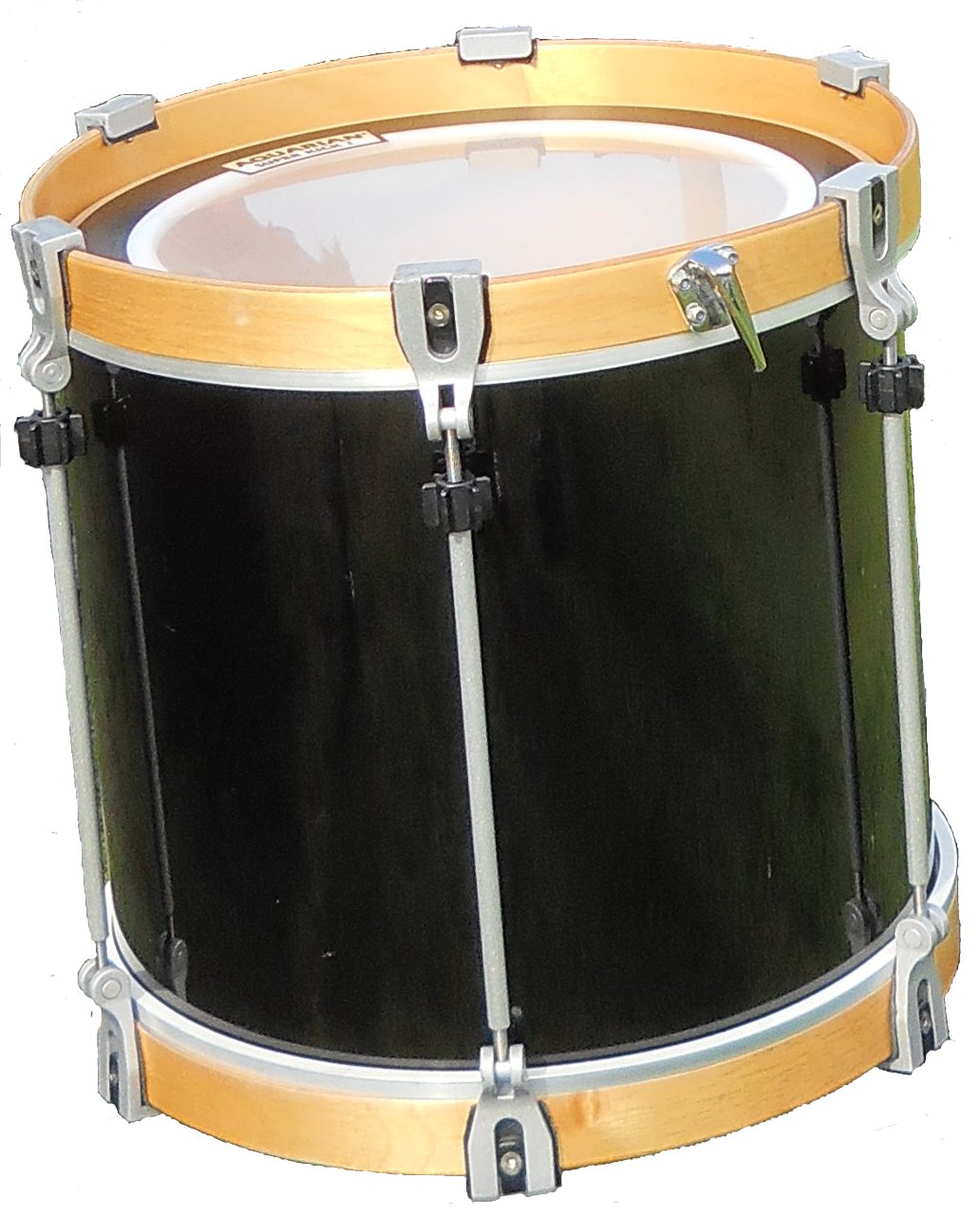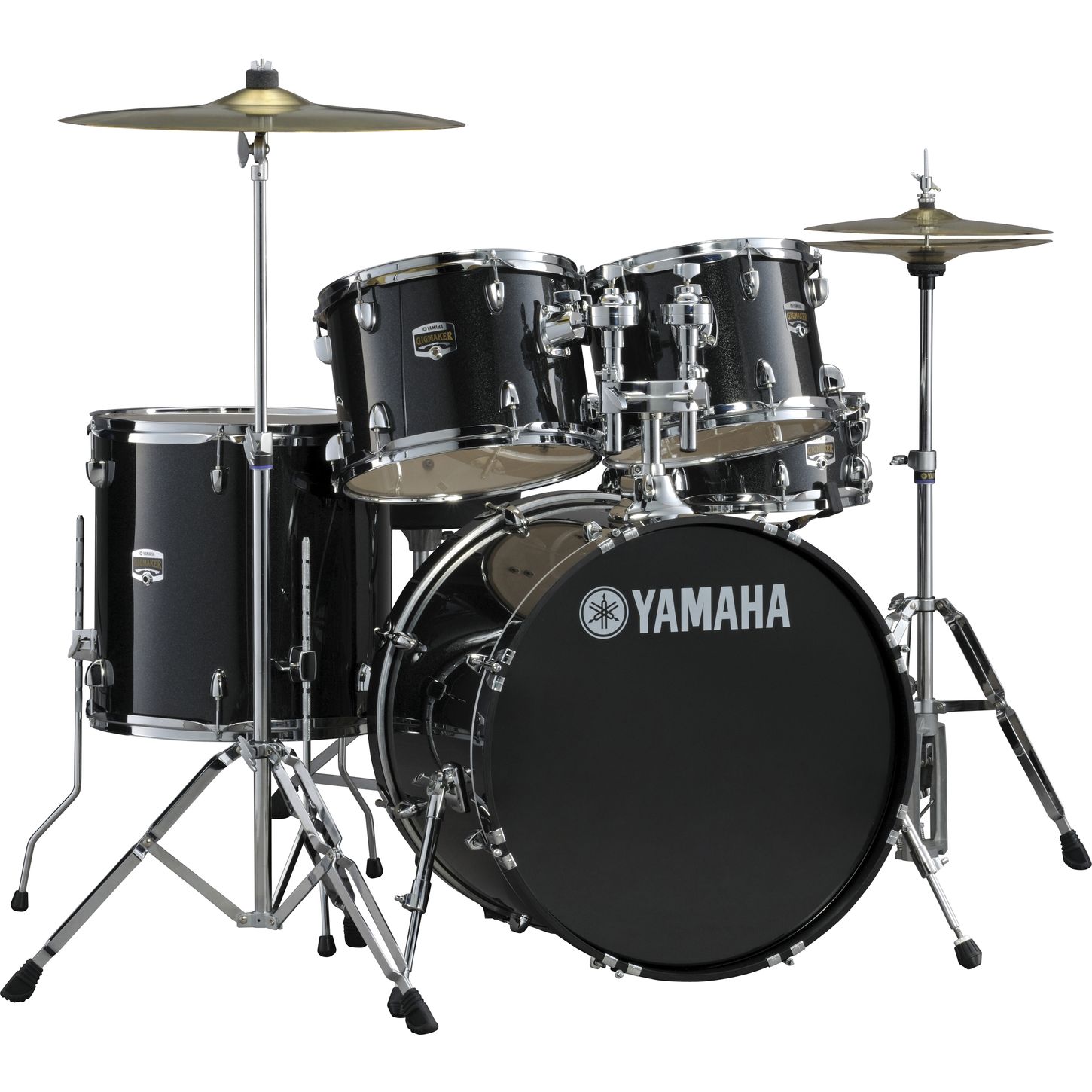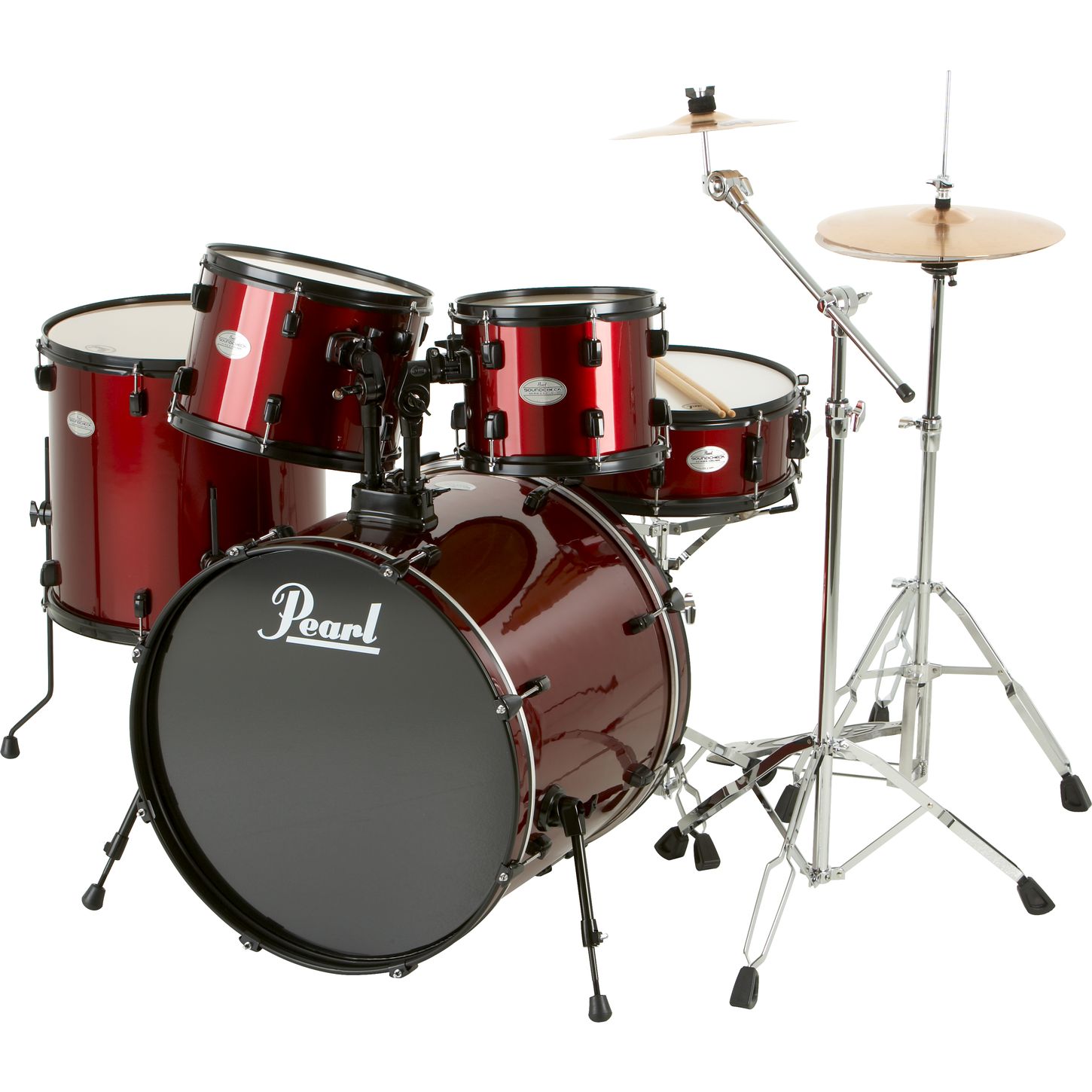 The drum is an associate of the percussion group of musical tools. Within the Hornbostel-Sachs classification system, it is a membranophone.[1] Drums contain at least one membrane, called a drum or drumhead epidermis, that is extended over a shell and struck, either directly with the player's hands, or with a drum stick, to produce sound. There is usually a resonance at once the underside of the drum, typically tuned to a somewhat lower pitch than the top drumhead. Other techniques have been used to cause drums to make sound, including the thumb roll. Drums are the world's oldest and most ubiquitous musical tools, and the basic design has remained unchanged for thousands of years virtually.[1]Drums may be enjoyed separately, with the player using a sole drum, and some drums including the djembe are almost always played in this way. Others are normally played in a set of two or more, all played by the one player, such as bongo drums and timpani. A variety of drums with cymbals form the basic modern drum set up together.
The drum is an associate of the percussion group of musical tools. Within the Hornbostel-Sachs classification system, it is a membranophone.[1] Drums contain at least one membrane, called a drum or drumhead epidermis, that is extended over a shell and struck, either directly with the player's hands, or with a drum stick, to produce sound. There is usually a resonance at once the underside of the drum, typically tuned to a somewhat lower pitch than the top drumhead. Other techniques have been used to cause drums to make sound, including the thumb roll. Drums are the world's oldest and most ubiquitous musical tools, and the basic design has remained unchanged for thousands of years virtually.[1]Drums may be enjoyed separately, with the player using a sole drum, and some drums including the djembe are almost always played in this way. Others are normally played in a set of two or more, all played by the one player, such as bongo drums and timpani. A variety of drums with cymbals form the basic modern drum set up together.Gigmaker 5Piece Standard Drum Set with 22quot; Bass Drum Black Glitter
 Drums are usually played out by striking with the palm, or with a couple of sticks. In many traditional ethnicities, drums have a symbolic function and are used in religious ceremonies. Drums are used in music therapy often, especially hand drums, for their tactile mother nature and easy use by a multitude of people.[2]In popular jazz and music, "drums" usually refers to a drum set up or a couple of drums (with some cymbals), and "drummer" to the person who takes on them.Drums received even divine status in places such as Burundi, where in fact the karyenda was symbolic of the charged electricity of the ruler.Construction[edit]Drum carried by John Unger, Company B, 40th Regiment New York Veteran Volunteer Infantry Mozart Regiment, December 20, 1863The shell almost has a round beginning over that your drumhead is extended invariably, but the shape of the remainder of the shell differs widely. Inside the western musical traditions, the most standard condition is a cylinder, although timpani, for example, use bowl-shaped shells.[1] Other shapes include a framework design (tar, Bodhr?n), truncated cones (bongo drums, Ashiko), goblet molded (djembe), and joined up with truncated cones (chatting drum).Drums with cylindrical shells can most probably at one end (as is the situation with timbales), or can have two drum minds. Single-headed drums contain a skin extended over a specific space typically, or higher one of the ends of an hollow vessel. Drums with two heads covering both ends of an cylindrical shell frequently have a small hole somewhat halfway between the two mind; the shell forms a resonating chamber for the resulting sound. Exceptions are the African slit drum, also known as a log drum as it is manufactured out of a hollowed-out tree trunk, and the Caribbean metallic drum, made from a metallic barrel. Drums with two mind can likewise have a couple of wires, called snares, organised across the lower part head, top mind, or both heads, the name snare drum hence.[1]
Drums are usually played out by striking with the palm, or with a couple of sticks. In many traditional ethnicities, drums have a symbolic function and are used in religious ceremonies. Drums are used in music therapy often, especially hand drums, for their tactile mother nature and easy use by a multitude of people.[2]In popular jazz and music, "drums" usually refers to a drum set up or a couple of drums (with some cymbals), and "drummer" to the person who takes on them.Drums received even divine status in places such as Burundi, where in fact the karyenda was symbolic of the charged electricity of the ruler.Construction[edit]Drum carried by John Unger, Company B, 40th Regiment New York Veteran Volunteer Infantry Mozart Regiment, December 20, 1863The shell almost has a round beginning over that your drumhead is extended invariably, but the shape of the remainder of the shell differs widely. Inside the western musical traditions, the most standard condition is a cylinder, although timpani, for example, use bowl-shaped shells.[1] Other shapes include a framework design (tar, Bodhr?n), truncated cones (bongo drums, Ashiko), goblet molded (djembe), and joined up with truncated cones (chatting drum).Drums with cylindrical shells can most probably at one end (as is the situation with timbales), or can have two drum minds. Single-headed drums contain a skin extended over a specific space typically, or higher one of the ends of an hollow vessel. Drums with two heads covering both ends of an cylindrical shell frequently have a small hole somewhat halfway between the two mind; the shell forms a resonating chamber for the resulting sound. Exceptions are the African slit drum, also known as a log drum as it is manufactured out of a hollowed-out tree trunk, and the Caribbean metallic drum, made from a metallic barrel. Drums with two mind can likewise have a couple of wires, called snares, organised across the lower part head, top mind, or both heads, the name snare drum hence.[1]Revolution Series Tenor drum in Flame Red Laquer RC
 On modern music group and orchestral drums, the drumhead is positioned over the starting of the drum, which in turn is placed onto the shell by the "counterhoop" (or "rim"), which is then held through a number of tuning screws called "tension rods" that screw into lugs placed evenly round the circumference. The head's pressure can be tweaked by loosening or tightening up the rods. Many such drums have six to ten tension rods. The audio of an drum depends upon many variables--including shape, shell thickness and size, shell materials, counterhoop materials, drumhead material, drumhead pressure, drum position, location, and dazzling angle and speed.[1]
On modern music group and orchestral drums, the drumhead is positioned over the starting of the drum, which in turn is placed onto the shell by the "counterhoop" (or "rim"), which is then held through a number of tuning screws called "tension rods" that screw into lugs placed evenly round the circumference. The head's pressure can be tweaked by loosening or tightening up the rods. Many such drums have six to ten tension rods. The audio of an drum depends upon many variables--including shape, shell thickness and size, shell materials, counterhoop materials, drumhead material, drumhead pressure, drum position, location, and dazzling angle and speed.[1]Pearl Soundcheck 5Piece Drum Set with Zildjian Cymbals Musician39;s
 Before the invention of stress rods, drum skins were fastened and tuned by rope systems--as on the Djembe--or pegs and ropes such as on Ewe Drums. Today these methods are hardly ever used, though look on regimental marching music group snare drums sometimes.[1] The head of an talking drum, for example, can be temporarily tightened by squeezing the ropes that connect the top and bottom heads. Similarly, the tabla is tuned by hammering a disc held in place about the drum by ropes stretching from the top to bottom head. Orchestral timpani can be quickly tuned to precise pitches by by using a foot pedal.Sound of your drum[edit]Several American Indian-style drums for sale at the Country wide Museum of the American Indian.Several factors determine the audio a drum produces, including the type, shape and construction of the drum shell, the type of drum heads it includes, and the strain of the drumheads. Different drum may seem have different uses in music. Take, for example, the present day Tom-tom drum. A jazz drummer might want drums that are high pitched, resonant and calm whereas a rock drummer may prefer drums that are loud, low-pitched and dry. Since these drummers want different sounds, their drums in a different way are produced just a little.The drum brain has the most effect how a drum sounds. Each kind of drum brain serves its own musical goal and has its unique sound. Double-ply drumheads dampen high rate of recurrence harmonics because they are heavier and they're suitable for heavy playing.[3] Drum minds with a white, textured coating in it muffle the overtones of the drum brain slightly, creating a less diverse pitch. Drum heads with central sterling silver or dark-colored dots have a tendency to muffle the overtones even more. And drum heads with perimeter audio rings mainly eliminate overtones (Howie 2005). Some jazz drummers stay away from thick drum mind, preferring single ply drum heads or drum mind with no muffling
Before the invention of stress rods, drum skins were fastened and tuned by rope systems--as on the Djembe--or pegs and ropes such as on Ewe Drums. Today these methods are hardly ever used, though look on regimental marching music group snare drums sometimes.[1] The head of an talking drum, for example, can be temporarily tightened by squeezing the ropes that connect the top and bottom heads. Similarly, the tabla is tuned by hammering a disc held in place about the drum by ropes stretching from the top to bottom head. Orchestral timpani can be quickly tuned to precise pitches by by using a foot pedal.Sound of your drum[edit]Several American Indian-style drums for sale at the Country wide Museum of the American Indian.Several factors determine the audio a drum produces, including the type, shape and construction of the drum shell, the type of drum heads it includes, and the strain of the drumheads. Different drum may seem have different uses in music. Take, for example, the present day Tom-tom drum. A jazz drummer might want drums that are high pitched, resonant and calm whereas a rock drummer may prefer drums that are loud, low-pitched and dry. Since these drummers want different sounds, their drums in a different way are produced just a little.The drum brain has the most effect how a drum sounds. Each kind of drum brain serves its own musical goal and has its unique sound. Double-ply drumheads dampen high rate of recurrence harmonics because they are heavier and they're suitable for heavy playing.[3] Drum minds with a white, textured coating in it muffle the overtones of the drum brain slightly, creating a less diverse pitch. Drum heads with central sterling silver or dark-colored dots have a tendency to muffle the overtones even more. And drum heads with perimeter audio rings mainly eliminate overtones (Howie 2005). Some jazz drummers stay away from thick drum mind, preferring single ply drum heads or drum mind with no mufflingand more enjoyable with these top tips for improving your drum setup
 The next biggest factor that affects drum sound is head stress resistant to the shell. When the hoop is located around the drum shell and head and tightened down with tension rods, the tension of the head can be tweaked. When the tension is increased, the amplitude of the sound is reduced and the frequency is increased, making the pitch higher and the quantity lower.
The next biggest factor that affects drum sound is head stress resistant to the shell. When the hoop is located around the drum shell and head and tightened down with tension rods, the tension of the head can be tweaked. When the tension is increased, the amplitude of the sound is reduced and the frequency is increased, making the pitch higher and the quantity lower.
{ 0 comments... Views All / Send Comment! }
Post a Comment